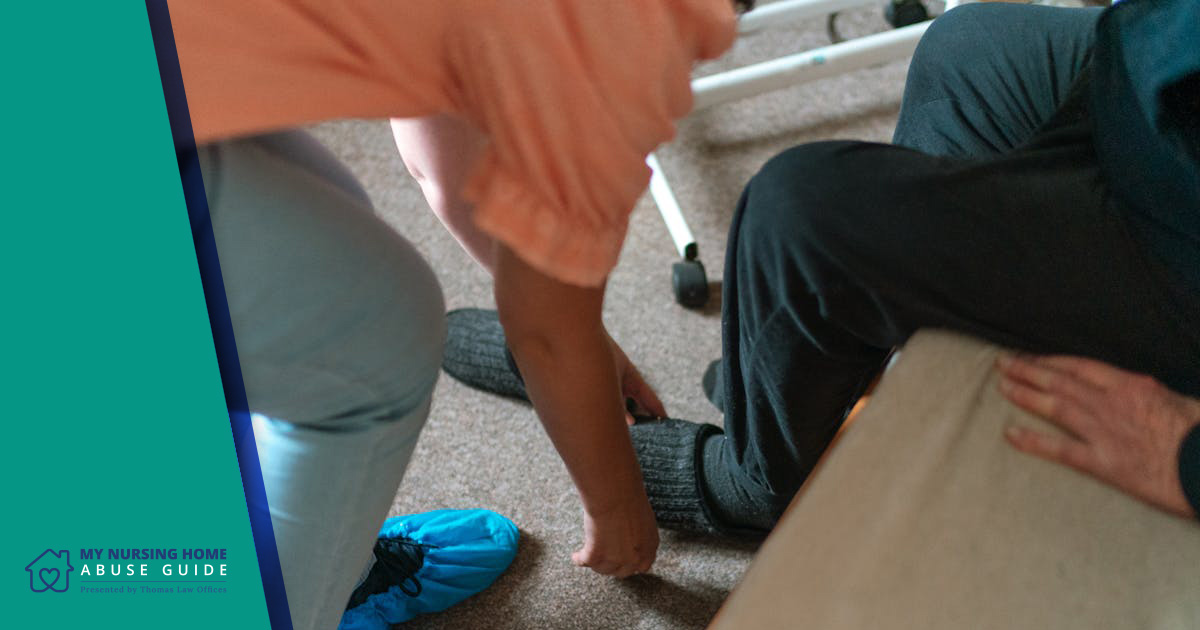Your Guide to Nursing Home Abuse & Prevention
Millions of elderly adults live in nursing home facilities.
Every one of them deserves to feel safe, protected, and respected.
Millions of elderly adults live in nursing home facilities.
Every one of them deserves to feel safe, protected, and respected.

Falling accidents in nursing homes are an ongoing and serious concern for families, caregivers, and administrators, as they can lead to devastating injuries, such as broken bones, head trauma, and long-term mobility issues.
Preventing serious injuries from falls requires a combination of proactive planning, individualized care, and an environment designed for safety. With the right training and precautions, many of these accidents can be avoided.
Older adults are naturally more prone to falling due to a variety of factors. Physical weakness, poor balance, the effects of medication, and cognitive impairments can all increase the likelihood of a fall.
Other additional risks may come from environmental hazards like poor lighting, slippery floors, or cluttered walkways. When these internal and external factors combine, the risk of injury grows significantly. Another common issue is undertrained staff or a high staff-to-resident ratio.
The chances of dangerous falls happening increase dramatically if residents aren’t monitored closely or assisted properly when moving around. Nursing homes must take these risks seriously by regularly assessing residents’ mobility and overall physical condition.
Preventing falls and related injuries begins with assessing each resident when they enter a nursing home, including their health history, level of mobility, and cognitive status. A thorough fall risk evaluation upon admission can identify residents who need additional supervision or assistive devices.
Evaluations should be updated regularly, especially after any changes in health status or medication.
Once risk factors are identified, the staff can implement tailored strategies. This could mean the installation of grab bars around toilets and showers, lowering the height of beds, or providing walkers and canes to residents who require them.
Proper footwear, such as well-fitting, non-slip shoes, also plays a key role in reducing accidents.
Nursing home staff have a vital role in fall prevention and must be properly trained to recognize the risk factors of a fall and how to respond quickly if a resident appears unsteady or at risk of falling. Consistent and ongoing staff education helps reinforce the best practices. It’s also essential that staff members monitor residents as they move throughout the facility and assist them with daily activities like getting out of bed, using the restroom, or walking to meals.
Communication among team members is essential. Staff should routinely update each other about changes in a resident’s behavior or physical condition. This helps ensure that fall risks don’t go unnoticed or unaddressed.
The layout of a nursing home can either contribute to or help prevent falls, as can the condition in which it’s kept. Care facilities must prioritize regular maintenance, making sure that floors aren’t slippery and are free of clutter. Handrails in hallways and bathrooms can provide residents with needed stability, especially those who suffer from limited mobility.
Adequate lighting throughout the building, including nightlights in resident rooms and common areas, also minimizes risk.
The placement of furniture matters, too. Clear, open walkways reduce the likelihood of stumbling or losing balance. Assistive devices like bed alarms and motion sensors can alert staff when a resident is moving unexpectedly, allowing them to intervene before a fall occurs.
Residents themselves can play a part in their own fall prevention as well. Encouraging light exercise, such as walking or stretching, helps maintain muscle tone and balance. Physical therapists can also work with residents to improve coordination and teach them how to move safely.
Residents should also be reminded to ask for help when needed. Sometimes pride or embarrassment causes individuals to attempt tasks without assistance, which can be dangerous.
Family members often notice subtle changes in their loved one’s health or behavior. Involving them in care planning and safety discussions adds another layer of oversight. Families can also help advocate for proper supervision and may offer helpful insight into a resident’s routines, habits, or preferences that could reduce fall risks.
Open communication between nursing home staff and families can build trust and help everyone stay focused on shared safety goals.
Even with the best prevention plan in place, accidents may still happen. When a resident falls, it’s critical that nursing home staff are ready to respond immediately and effectively. Medical attention should be provided as quickly as possible, and the accident should be thoroughly documented and reviewed to identify and deal with any contributing factors.
After there’s a fall, staff should reevaluate the resident’s care plan to see if it’s still effective. A new assistive device or a modification in medication could be necessary. Learning from each incident helps prevent future falls.
Ultimately, fall prevention in nursing homes is about creating a culture of safety.
This includes staff who take pride in resident care, administrators who invest in training and facility upkeep, and residents and families who actively participate in care planning. Preventing falling accidents isn’t just about reacting to dangerous issues; it’s about creating an environment where risks are minimized before anyone gets hurt.
When nursing homes commit to this level of care, they not only reduce injuries but also improve the quality of life for every resident who calls the facility home.
If your loved one has fallen in a nursing home, and it may be due to negligence, My Nursing Home Abuse Guide has the resources for you to take those next steps.
This website was created and is maintained by the legal team at Thomas Law Offices. Our attorneys are experienced in a wide variety of nursing home abuse and neglect cases and represent clients on a nationwide level. Call us or fill out the form to the right to tell us about your potential case. We will get back to you as quickly as possible.
866-351-2504